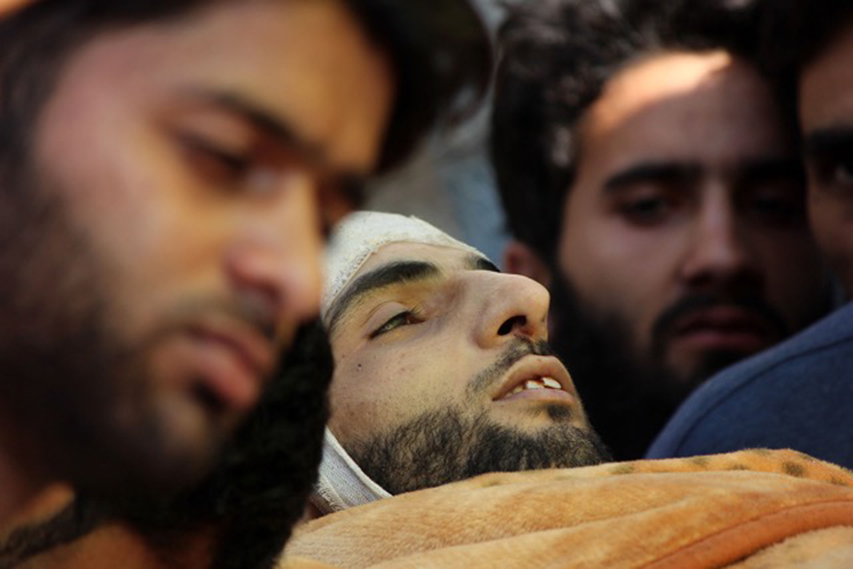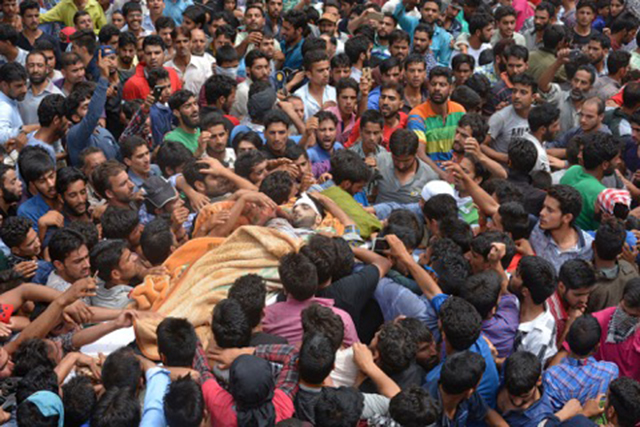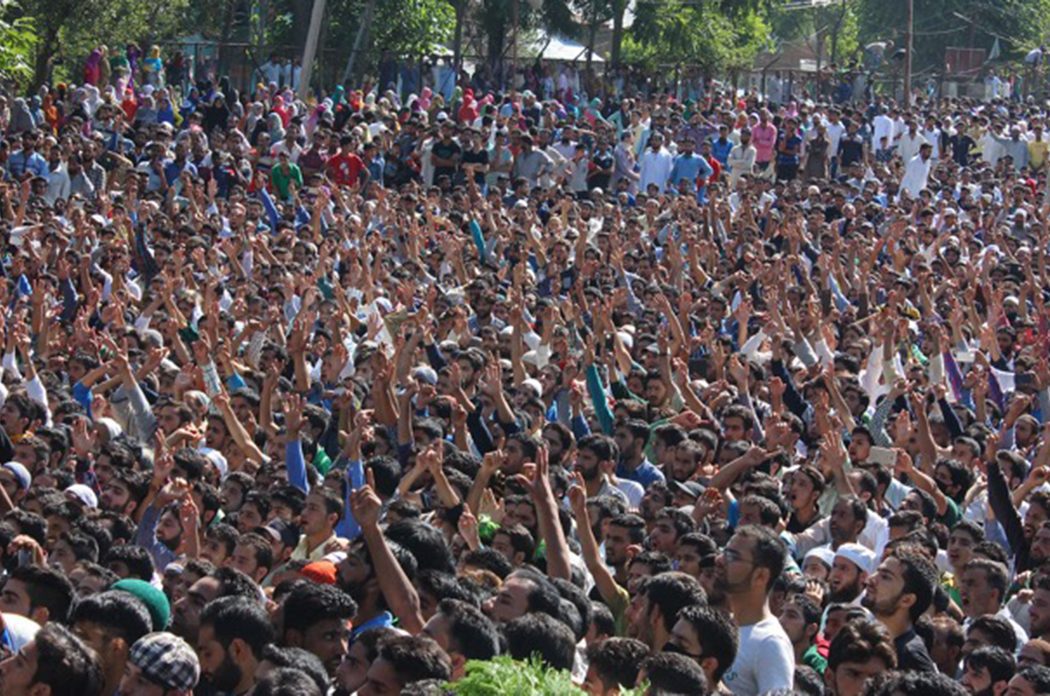Burhan Wani’s funeral demonstrates how the sentiment for Azadi among Kashmiris has only grown manifold over the years, says our correspondent.
I have heard of huge crowds outside the houses of film stars and celebrated athletes. I have heard that people get a little crazy when they see their heroes, but I have never seen such a scene in Kashmir. There were no such stars, no such heroes. But on 9 July, I saw hundreds of young people encircling a militant who was chanting slogans in support of Azadi during the funeral of Hizbul Mujahideen commander Burhan Muzaffar Wani in his south Kashmir hometown of Tral.
I was born a year after the infamous 1987 elections, and a year before the beginning of the armed movement against Indian rule in Kashmir. In my life, I have seen many funerals of militants—militants, whose bravery we used to discuss in our classrooms—but never have I seen such a presence of people at any funeral. I have never seen people running after militants, extending their hands so that they could shake hands with them. During the funeral prayers of the Burhan Wani, I saw a huge crowd encircling the militants who had come to pay their respects to their slain commander. I saw people getting crazy as if there was some sports or a film star. I saw people kissing and hugging these militants.
“I told the youth, ‘Why are you getting so close to these militants? They have come to pay tribute to Burhan, let them do that and don’t create a circle around them; they will be identified and may be caught by army.’ But within less than half an hour, another militant came to attend the funeral and I too did the same thing, what other guys were doing,” said 26-year-old Mudasir Ahmad. “I thought it is a historical moment and maybe I will never see him again, so I extended my hand and passed it through countless hands and touched the hand of the militant.”
“I told the youth, ‘Why are you getting so close to these militants? They have come to pay tribute to Burhan, let them do that and don’t create a circle around them; they will be identified and may be caught by army.’ But within less than half an hour, another militant came to attend the funeral and I too did the same thing, what other guys were doing,” said 26-year-old Mudasir Ahmad.
Scores of militants attended the funeral of their top commander. I saw a militant in army fatigues, with long hair and a beard, leaving among the crowd after paying tribute. I saw youth carrying a militant on their shoulders as he entered the gates of Eidgah Tral. I saw him shouting slogans in support of Azadi. I heard him chanting “Mubarak Ho Mubarak Ho, Tral Ko Mubarak Ho!” A young man identified him as Wasim, from Shopian. For the time he was present in the crowd, people were advised not to take any pictures.
I remember when Saleem Khan, another top militant commander who hailed from Tral, was killed in 2001. I was still in school, and I remember people in large numbers converging on his village of Lorrow Jagir to participate in his funeral. A decade and a half has passed, but I clearly recollect people calling his death a great loss to the struggle, the same way people talk about Burhan today. In the intervening years, Tral, which has remained a hotbed of militancy since 1989, saw new faces rising up through the ranks of the Hizbul Mujahideen. None of them, however, achieved the fame Burhan did in his six years as an active militant.
“I’m 70 years old,” said Ghulam Mohammed, who walked 12 kilometres to attend Burhan’s last rites. “In my entire life or in the past 27 years of conflict, I have not seen such a sea of people at any funeral.”

There are those who call these young idealists, “terrorists”. I want to ask them in which terrorist’s funeral will you witness the participation of hundreds and thousands of men, women and children who have defied restrictions and risked losing their lives to bullets. What do you say about the sentiment that makes our youth so daring that they pelt stones even when they know that they will face bullets in retaliation; they know that they will be killed and yet they keep fighting. I ask the people of India to wake up to the reality of Kashmir and understand that the issue needs to be resolved. The longing for freedom in Kashmir will not die its own death, as some would want the people of India to believe.
Burhan Muzaffar Wani was among three militants killed by security forces in south Kashmir’s Kokernag area on 8 July. The moment the news that he was one of the three was confirmed, thousands of people marched towards Tral. The giggles and the Eid celebrations were soon overtaken by Azaadi and pro-Burhan slogans. Hundreds of youths from various parts of the Valley—even some from Jammu division—reached his village of Sharifabad that night itself, even before Burhan’s body was brought there.
Separatists called for a shutdown and the government imposed restrictions. It was clear on that night itself what the coming days would be like. There have been protests throughout the Valley, whether it is Anantnag, Pampore, Sopore, Srinagar or Baramulla. Everywhere, the crowd chanted, “Burhan tere khoon se inquilab ayega!” At many places, clashes were reported between protesters and security forces. Sensing trouble, the Mehbooba Mufti-led PDP-BJP government suspended mobile phone and internet services in the Valley. Despite strict restrictions imposed by the authorities, an estimated three lakh people participated in Burhan’s funeral.
Sensing trouble, the Mehbooba Mufti-led PDP-BJP government suspended mobile phone and internet services in the Valley. Despite strict restrictions imposed by the authorities, an estimated three lakh people participated in Burhan’s funeral.
Syed Ali Geelani, chairman of the hardline faction of the Hurriyat Conference, termed the peoples participation in the funeral as a clear referendum. “Burhan’s martyrdom has proven that the struggle for freedom is holy and is justified as the whole nation supports it.”
The son of a higher secondary school principal, Burhan joined the Hizbul Mujahideen in 2010 at the age of 15, after his brother, who was also killed by security forces last year, and he were allegedly beaten up by the police for “no reason”. His father Muzaffar Ahmad Wani told me in an interview two years ago that it “was the moment that changed Burhan and made him become a militant.”
His youth, and his bravado in sharing pictures and videos with his fellow militants on social media, made him a household name in Kashmir; they would frequently go viral, and were often run on Indian news channels for days. He has been widely credited with reviving the armed resistance in Kashmir.

“I swear by Allah that I have never participated in any militant’s funeral in my entire life or taken part in any protest march, but today I couldn’t stop myself,” said a childhood friend, who belongs to an élite family. “I participated in Burhan’s funeral today and I was asking myself, if people like him are not heroes then who?”
There is nothing new in women participating in a militant’s funeral in Kashmir, but for the first time I saw a girl as young as six and a lady as old as 90 marching towards the Eidgah of Tral to participate in the funeral. I saw thousands of young girls coming out from their homes, marching towards Burhan’s funeral amid slogans in support of Azadi and the militants.
Since my childhood, I have seen volunteers offering juice and water to people during funerals, but for the first time, I saw people setting up langars, collecting cooked rice and vegetables from village to village to feed the people who, despite the restrictions, had come from different parts of the state. Hundreds of families cooked rice twice, thrice, so that the hungry can be fed.
Not only Muslims, a large number of Sikhs also visited Burhan’s home and the Eidgah. I saw an old Sikh man waiting in queue for almost an hour to get a glimpse of the slain militant. There were scores of Sikh youth present, offering water to people who had come to attend the funeral. Since my childhood, I have seen volunteers offering juice and water to people during funerals, but for the first time, I saw people setting up langars, collecting cooked rice and vegetables from village to village to feed the people who, despite the restrictions, had come from different parts of the state. Hundreds of families cooked rice twice, thrice, so that the hungry can be fed.
I remember a time when people would run away from their homes if they heard the army was coming towards their village, or if an encounter happened in the vicinity. But this situation has also changed. Now, if there is an encounter between militants and security forces anywhere in the Valley, the local population often engages in stone pelting so that the militants can escape the scene. A day after Burhan’s funeral, I saw people marching towards the village of Midoora; some people had been heard saying that Zakir, an associate of Burhan, was trapped there. Hundreds of youths descended upon the village, but the news was fake.
There is so much anger among the youth in Kashmir today. On 11 July, at around 2:30 pm, I was on a bike, driving back from a relative’s home, when I saw some youths chasing an army patrol party. Burhan Wani’s killing sparked days of deadly clashes in Kashmir. At least 38 people have been killed in police and paramilitary firing in different parts of the Valley since his death. Around 2,000 people have been injured in the clashes.
I remember a time when people would run away from their homes if they heard the army was coming towards their village, or if an encounter happened in the vicinity. But this situation has also changed. Now, if there is an encounter between militants and security forces anywhere in the Valley, the local population often engages in stone pelting so that the militants can escape the scene.
Over a hundred people are being treated for severe eye injuries after security forces fired pellet guns to contain protests. Pellet guns were introduced in Kashmir in 2010, when more than 100 people were killed in police and paramilitary firing, as a non-lethal weapon to disperse protesters. Hundreds of people have become its victims since then; many have lost their eyesight, either partially or permanently.
I asked a student why, when so many people outside Kashmir call him a “dreaded terrorist”, Kashmiris see Burhan Wani as their hero. “People not only see Burhan as their hero, they love him in Kashmir. Many in India are surprised to see the outpouring of love for, and rage against the killing of, Burhan Wani. For Indians, a terrorist was killed, but for Kashmiris, a hero was martyred.” She added that Burhan is a hero to Kashmiris “because he did what most couldn’t dare to do after witnessing the gory years of the ’90s. He rebelled against the atrocities of India. Years of protesting peacefully haven’t borne any fruit, so people saw a glimpse of hope in Burhan.”
Despite the huge participation of people during the 2014 elections, which many claimed as an Indian victory in Kashmir, Burhan’s funeral demonstrated how the sentiment of Azadi among Kashmiris has only grown manifold over the years. At the funeral, I saw a grandfather, a father, a son, a daughter, a mother and a grandmother, chanting in unison: “Hum Kya Chahte? Azaadi!”
Photos: Sameer Mushtaq















Zubair
Mr Bilal ,
Burhan Bhai didn’t join militant regime after the martyrdom of his brother Khalid
U better know he joined militancy in 2010 , while Khalid was martyed in 2015 .
Please correct the information
With Regards
Zedd Trali